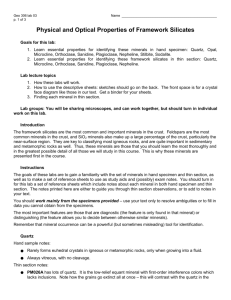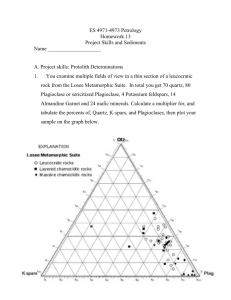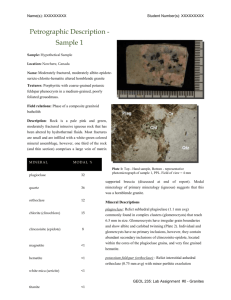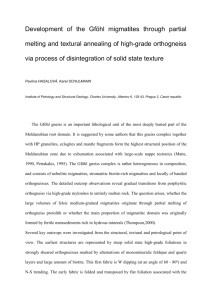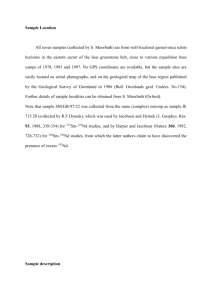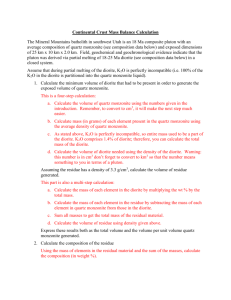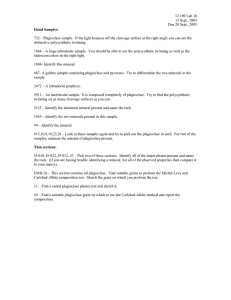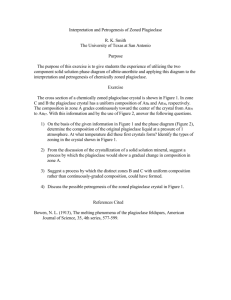9. LARGE-SCALE K- AND Si-METASOMATISM TO FORM THE MEGACRYSTAL QUARTZ MONZONITE
advertisement
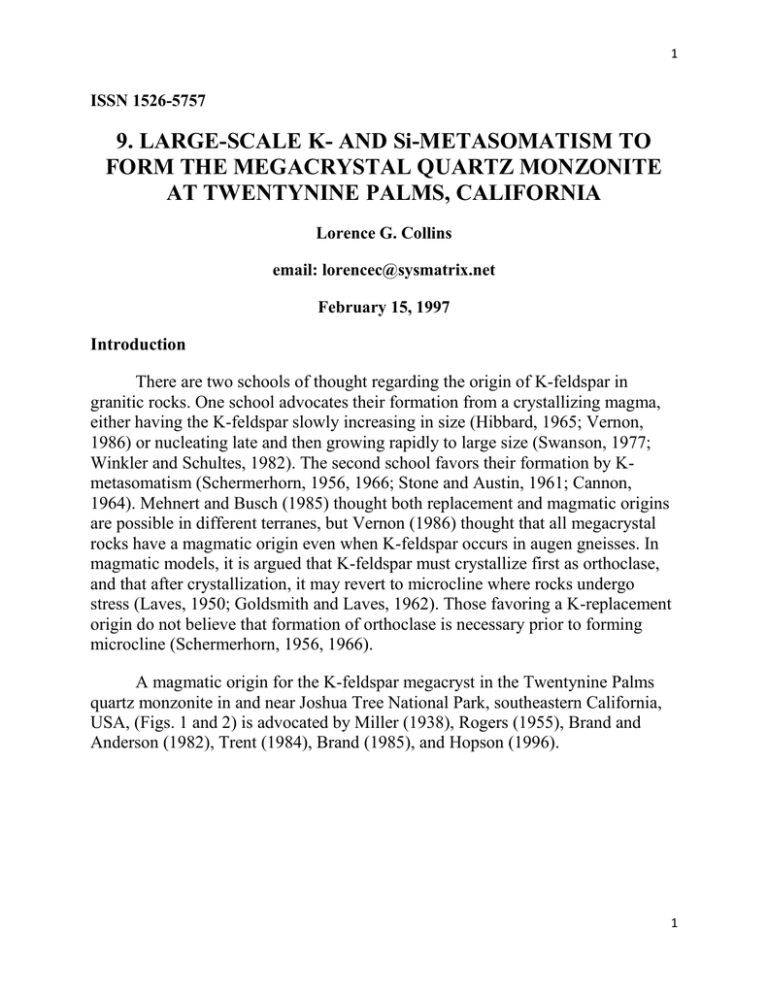
1 ISSN 1526-5757 9. LARGE-SCALE K- AND Si-METASOMATISM TO FORM THE MEGACRYSTAL QUARTZ MONZONITE AT TWENTYNINE PALMS, CALIFORNIA Lorence G. Collins email: lorencec@sysmatrix.net February 15, 1997 Introduction There are two schools of thought regarding the origin of K-feldspar in granitic rocks. One school advocates their formation from a crystallizing magma, either having the K-feldspar slowly increasing in size (Hibbard, 1965; Vernon, 1986) or nucleating late and then growing rapidly to large size (Swanson, 1977; Winkler and Schultes, 1982). The second school favors their formation by Kmetasomatism (Schermerhorn, 1956, 1966; Stone and Austin, 1961; Cannon, 1964). Mehnert and Busch (1985) thought both replacement and magmatic origins are possible in different terranes, but Vernon (1986) thought that all megacrystal rocks have a magmatic origin even when K-feldspar occurs in augen gneisses. In magmatic models, it is argued that K-feldspar must crystallize first as orthoclase, and that after crystallization, it may revert to microcline where rocks undergo stress (Laves, 1950; Goldsmith and Laves, 1962). Those favoring a K-replacement origin do not believe that formation of orthoclase is necessary prior to forming microcline (Schermerhorn, 1956, 1966). A magmatic origin for the K-feldspar megacryst in the Twentynine Palms quartz monzonite in and near Joshua Tree National Park, southeastern California, USA, (Figs. 1 and 2) is advocated by Miller (1938), Rogers (1955), Brand and Anderson (1982), Trent (1984), Brand (1985), and Hopson (1996). 1 2 Fig.1. Geologic map showing five locations (ab, upper left side; cde, lower right corner) where felsic Gold Park diorite occurs in areas less than mapping scale and with transition stages to the megacrystal Twentynine Palms quartz monzonite. Locations are on file with the museum at Twentynine Palms National Park. 2 3 Fig. 2. Topographic and geologic map in Bartlett Mountains northwest of Joshua Tree, California (Hopson, 1996), showing a sixth location of remnant felsic diorite interlayered with megacrystal quartz monzonite. (Joshua Tree North, 7 and 1/2 Minute Quadrangle, California, T1N, R6E, Section 21, center of SE quarter, four aligned red dots) Microscopic textures, suggesting that fluids depositing K-feldspar have corroded and replaced plagioclase, were noted by Rogers (1955). He decided against K-metasomatism, however, because he did not find plagioclase crystals in the original rock as large as the largest megacrysts (up to 16 cm long). In the field, the Twentynine Palms quartz monzonite (Figs. 1 and 2) appears magmatic because 3 4 it contains large megacrysts of K-feldspar and lacks megascopic evidence for deformation (Fig. 3). Fig. 3. Megacrystal Twentynine Palms quartz monzonite in Bartlett Mountains northwest of Joshua Tree, California (Hopson, 1996), but also typical of megacrystal quartz monzonite plutons in Joshua Tree National Park. K-feldspar megacrysts are about 4 cm long. While agreeing with Mehnert and Busch (1985) that both replacement and magmatic origins are possible for the formation of K-feldspar megacrysts, I present evidence that K-feldspar megacrysts in the Twentynine Palms quartz monzonite in and near the Joshua Tree National Park are not magmatic but are formed from Kmetasomatism of Gold Park diorite and Precambrian Pinto gneiss. Twentynine Palms quartz monzonite The megacrystal Twentynine Palms quartz monzonite contains pink to gray, subhedral to euhedral crystals of microcline (25-50 vol. %), which are 1-5 cm long in most places (Fig. 3), but range up to 16 cm long. The megacrysts generally 4 5 contain inclusions of groundmass minerals (10-20 vol. %), but in some places, inclusions are >50 vol. %. The inclusions occur in clusters or veinlike stringers and rarely show preferred orientations. Borders of megacrysts are generally quite irregular and enclose groundmass minerals, although megascopically appearing to have sharp edges. The megacrysts commonly contain plagioclase (An-15) as rod perthite (up to 20 vol. %). Locally, megacrysts have planar parallel orientations, but random orientations are more common (Fig. 3). The groundmass is dominantly plagioclase (45-65 vol. %) and hornblende (10-20 vol. %), but may also contain biotite (1-5 vol. %). Accessory minerals include apatite, allanite, sphene, quartz, magnetite, zircon, myrmekite, and epidote. Microcline (<10 vol. %) may be found in the groundmass, but in some places, only in megacrysts. Plagioclase generally contains few inclusions, is normally zoned and/or albite-, pericline-, and/or Carlsbad-twinned, has irregular borders, and ranges from 2-10 mm long. Gold Park diorite The Gold Park diorite is variable and locally changes in composition and grain size within a few meters (Brand, 1985; Hopson, 1996). The rock is fine- to coarse-grained but mostly medium-grained, ranges from black, to black and gray, to white and is composed of plagioclase (35-65 vol. %), hornblende ± biotite (2050 vol. %) and ± clinopyroxene ± olivine. Plagioclase crystals are commonly twinned according to albite, pericline, and Carlsbad laws and normally zoned, ranging mostly from An20 to An50 and above An50 by Miller (1938). Accessory minerals include magnetite, epidote, sphene, allanite, zircon, and apatite. Alteration minerals are actinolite, epidote, calcite, and chlorite. Hornblende tends to dominate; biotite-bearing facies are less common. A fine- to medium-grained mafic Gold Park diorite, containing >20 vol. % hornblende ± biotite ± clinopyroxene ± olivine, is the facies mapped by Rogers (1954, 1955), Brand (1985), and Hopson (1996). Also present are remnants of a medium-grained, felsic facies (Fig. 4), containing <20 vol. % hornblende ± biotite. The felsic facies was not mapped separately by these authors and borders the megacrystal quartz monzonite or occurs as small islands in it (Fig. 1 a-e; Fig 2). 5 6 Fig. 4. Felsic diorite remnant layer (~0.5 m thick; left side under knife and at bottom left) in megacrystal Twentynine Palms quartz monzonite in Bartlett Mountains northwest of Joshua Tree, California (four red dots in Fig. 2). On right side of image, loose K-feldspar megacrysts have slid down an eroded slope of quartz monzonite (more than 100 m high) to cover portions of the felsic diorite layer. Pinto gneiss The Pinto gneiss consists of interlayered, fine- to medium-grained, metamorphosed granitic and mafic igneous rocks. In the mafic rocks, laths of plagioclase may be as much as 2.5 cm long. Granitic gneisses generally contain 6 7 alternating biotite- and feldspar-rich bands, and plagioclase is commonly zoned. Near the megacrystal Twentynine Palms quartz monzonite, cataclastic portions of the Pinto gneiss may contain megacrysts of microcline, but generally these megacrysts are no more than 2 cm long. Cataclasis and transitions All varieties of Gold Park diorite show some degrees of cataclasis, but the more feldspar- or biotite-rich, medium-grained varieties are generally more strongly affected by cataclasis than fine-grained mafic facies containing abundant hornblende. As a consequence, the fine-grained mafic facies is preserved and mappable, but the more-felsic, medium-grained facies is commonly sheared (or crushed), replaced, and grades into the megacrystal quartz monzonite. For example, in Fig. 4, along strike and extending beyond the edge of the picture through a distance of 50 m, the felsic diorite gradually grades into the megacrystal quartz monzonite. Where crystals in the felsic diorite become progressively crushed, hornblende is replaced by quartz, and plagioclase is replaced by Kfeldspar (Fig. 5). First appearance of K-feldspar occurs as islands in plagioclase. Then, the K-feldspar may replace most of the plagioclase crystal and eventually grows to become a megacryst. 7 8 Fig. 5. Felsic diorite, showing cataclastic texture. Broken groundmass matrix, consisting of hornblende (brown and green), quartz (clear-white and gray), and plagioclase (gray and dark gray), surrounds larger islands of albite-twinned plagioclase (white to gray). In center and center left are two microcline crystals (dark gray) with irregular borders against the granulated groundmass. Microcline is in earliest stages of replacement and contains minor wartlike myrmekite with tiny quartz vermicules (barely visible) along borders of the microcline. Microcline is 1 to 5 vol. % of the rock. Normal, undeformed, felsic Gold Park diorite (Fig. 4) has crystals of hornblende and plagioclase all about the same size. Where primary Gold Park diorite is unsheared, hornblende and biotite generally lack any inclusions except for local poikilitic intergrowths of tiny plagioclase, magnetite, or sphene crystals. Where felsic diorite exhibits a cataclastic texture, however, hornblende may also contain tiny islands of microcline and/or quartz to form sieve textures (Fig. 6). Biotite may also develop quartz sieve textures or curved quartz veinlets. 8 9 Fig. 6. Felsic diorite, showing slight cataclastic texture. Hornblende (brown and green) has a sieve texture of tiny islands of microcline (gray) and quartz (white, gray, and cream). Albite-twinned plagioclase (white and gray) is in upper left. Microcline is less than 1 vol. % of the rock. [See also Fig. 5 in http://www.csun.edu/~vcgeo005/Nr3Myrm.pdf, which shows a well-developed quartz sieve texture in hornblende.] Progressively closer to the megacrystal quartz monzonite, microcline in sieve textures in the hornblende grows larger and coalesces so that microcline may appear to be primary, seeming to fill interstices between hornblende crystals. Still closer, microcline grows to form the megacrysts in the quartz monzonite while hornblende progressively disappears. Where tiny hornblende inclusions remain in interiors of a megacrysts or straddle borders, the hornblende crystals generally have granulated borders with ragged edges and may be riddled with quartz. With increasing deformation, where Carlsbad-, albite-, and pericline-twins in plagioclase are bent, broken, or strained, microcline also appears inside the plagioclase as tiny, irregular islands or veins (Figs. 7 and 8). Progressively into the quartz monzonite, the plagioclase is nearly completely replaced by the microcline, inheriting the Carlsbad-twinning from the plagioclase (see also Kennedy, 1953). 9 10 Fig. 7. Felsic diorite, showing deformed (bent) Carlsbad- and albite-twinned plagioclase crystal (light and dark gray). Other large plagioclase crystals (left side) have cataclastically broken grain boundaries. Hornblende crystal (brown, bottom) is adjacent to tiny grains of quartz (clear white). Microcline (light gray) is in earliest stages of replacement of deformed plagioclase and occurs as a few tiny irregular blebs just above the hornblende and quartz in the bottom part of the deformed plagioclase. Microcline is much less than 1 vol. % of the rock. 10 11 Fig. 8. Felsic diorite shows slightly deformed (fractured) Carlsbad- and albitetwinned plagioclase crystal (cream gray and gray) that fills most of image. Tiny irregular islands and veinlets of microcline (black-gray) replace portions of both halves of the Carlsbad-twinned plagioclase crystal. [Similar interior replacements of Carlsbad-twinned plagioclase are shown in Fig. 7, Fig. 8 and Fig. 9 at http://www.csun.edu/~vcgeo005/Nr2Myrm.pdf and in Fig. 6 at http://www.csun.edu/~vcgeo005/Nr3Myrm.pdf. Discussion If the K-feldspar megacrysts formed from a melt, first trace appearances in diorite should be orthoclase crystallizing in interstices between earlier-formed hornblende and plagioclase and not as interior, irregular islands in relativelycalcic cores of zoned plagioclase. Because these K-feldspar islands are found in cores of deformed or strained plagioclase crystals in non-uniform distributions and sizes (Fig. 8), as opposed to magmatic, exsolution antiperthites where enclosed Kfeldspar islands are relatively uniform in distribution and size and in which the plagioclase is not deformed or strained, the K-feldspar is interpreted to be subsolidus and replacement in origin. 11 12 Moreover, where replacements of plagioclase by K-feldspar are in early stages, ragged edges of plagioclase occur against the encroaching K-feldspar, and islands of plagioclase may remain in the K-feldspar in optical continuity with large remnant portions of the unreplaced plagioclase crystal (Fig. 9 and Fig. 10). Fig. 9. Cataclastically-broken felsic diorite, showing fractured plagioclase crystals (dark gray, light gray; bottom and left) being replaced by microcline (white; center and upper left). Hornblende (brown; upper right) has very minor quartz sieve texture. Unfractured microcline penetrates along fractures (replacing the plagioclase) and surrounds island remnants of plagioclase that are optically continuous with large unreplaced portions of the plagioclase. 12 13 Fig. 10. Cataclastically-broken felsic diorite, in transitional rock between unaltered, undeformed, felsic diorite (Fig. 4) and megacrystal quartz monzonite (like that shown in Figs. 3 and 4). This photomicrograph was taken from a sample 10 m along strike from Fig. 4. Image shows a tiny portion of a less than 1-cm-long microcline crystal in earliest stage of becoming a megacryst (3 to 4 cm long). Microcline (dark gray; top and left) encloses, penetrates in veins, and replaces plagioclase (cream-gray, light gray). Large plagioclase islands are optically continuous with adjacent tiny islands (blebs) of plagioclase in microcline. Large plagioclase islands are locally myrmekitic, containing elongate-oval cross-sections of quartz vermicules (black to gray). Tiny biotite crystals (light tan) are poikilitically enclosed in plagioclase (bottom). Continued growth of microcline causes local complete replacements of plagioclase, and this microcline may continue to grow and surround cataclasticallybroken groundmass minerals and eventually produce a microcline megacryst. In this process remnants of crushed groundmass minerals, as well as other microcline grains which were in early stages of replacement of plagioclase, may be enclosed in the growing megacryst. The final megacryst in some places may be full of mineral fragments (more than 50 vol. %) that are in various stages of replacement (Fig. 11). 13 14 Fig. 11. Tiny portion of a microcline megacryst (dark gray), 2 to 3 cm long, in Twentynine Palms quartz monzonite. Megacryst contains more than 50 vol. % fragments of quartz and plagioclase (gray and white) and a few tiny euhedral sphene crystals (brown), all remnants of a cataclastically deformed diorite. Hornblende is absent and presumably replaced by quartz and/or microcline. In hand specimen, the megacryst looks like one of those shown in Figs. 3 and 4 and gives no outward clue that it contains abundant inclusions. In most megacrysts, inclusions are less abundant (5 to 20 vol. %). In some megacrysts mineral fragments are preserved in trains of granulated minerals from one side of the megacryst to the other and represent a former shear zone. The microcline of the megacryst, however, shows no off-set by shearing or deformation, and, therefore, must be younger than the shearing. Furthermore, the lack of K-feldspar in the groundmass adjacent to the megacrysts in some places is very unusual for a magmatic rock if the K-feldspar crystallized early or even late from magma. All of the above relationships further support a replacement origin for the megacrysts. Simultaneous origin of myrmekite and megacrysts 14 15 In some hypotheses for explaining the origin of myrmekite, K-feldspar is considered to be primary, whereas myrmekite is thought to be a later, secondary alteration (Phillips, 1974; Castle and Lindsley, 1993; Hibbard, 1979, 1987). Four kinds of evidence, however, support a simultaneous replacement origin for both microcline and myrmekite in the megacrystal quartz monzonite. The first is based on the observation that quartz vermicules in myrmekite in different places in the quartz monzonite exhibit a range in size of the maximum thicknesses. Maximum sizes of vermicules are tiny where non-quartz-bearing plagioclase adjacent to myrmekite is sodic, intermediate where plagioclase compositions are intermediate, and coarse where plagioclase is relative calcic. Significantly, these size correlations correspond to compositions of primary plagioclase across gradational transitions from the Twentynine Palms quartz monzonite into Pinto gneiss or Gold Park diorite that lack microcline and myrmekite and lack cataclasis. Such correlations would be unlikely if myrmekite were formed later by exsolution because how can introduced magmatic body control its plagioclase Ca-content to match the Ca-content in its wall rocks (Collins, 1988; Hunt et al., 1992)? Second, a relatively large myrmekite grain, adjacent to K-feldspar of smaller size and in earliest stages of replacement, could not possibly be formed by exsolution because sufficient Ca and Na could never be dissolved in the small volumes of the high-T K-feldspar to produce the larger volumes of plagioclase and quartz vermicules in the adjacent myrmekite. Moreover, if Ca+2 and Na+1 ions were brought into the quartz monzonite at a later time in hydrous fluids and replaced primary K-feldspar to form myrmekite, then in some places myrmekite should be found in fractures or completely replace the K-feldspar, and that is not the case. [See examples of Ca- and Na-metasomatism in Fig. 2 and Fig. 3 in http://www.csun.edu/~vcgeo005/Nr4CaMyrm.pdf. Third, both microcline and myrmekite are undeformed where plagioclase albite-, pericline-, and Carlsbad-twins are strongly bent, and/or broken (Fig. 7, Fig. 8, and Fig. 9). How can this be possible if the microcline were formed in magma? Fourth, in some megacrysts small microcline crystals, whose optic orientations are different from the optic orientation of microcline in most of the megacryst, are inside the megacrysts and bordered by myrmekite. Neither could the bordering myrmekite exsolve from such tiny crystals nor could introduced Caand Na-bearing fluids penetrate the megacrysts to form this myrmekite without leaving a trail of myrmekite from the edges of the megacrysts to the isolated disoriented microcline grains. [See Fig. 2 in http://www.csun.edu/~vcgeo005/Nr2Myrm.pdf.] 15 16 Fig. 2 from Nr2Myrm.pdf. This photo shows a cathodoluminescent image of textures in deformed diorite in transition towards the myrmekite-bearing granite. Two plagioclase crystals show remnant zoning. See article for more information. All of these relationships support a simultaneous origin for both microcline and myrmekite and negate a magmatic origin. Other relationships Brand (1985) reported that the Gold Park diorite was younger than the quartz monzonite because the diorite contained angular fragments of the quartz monzonite. A re-examination of the outcrops show this relationship to be true, however, the diorite that contains the quartz monzonite fragments is not the Gold Park diorite but instead is probably part of the younger Independence dike swarm (Chen and Moore, 1979). Another older diorite, which probably is a mafic facies of the Gold Park diorite, occurs in the same locality and shows evidence of being replaced by the megacrystal quartz monzonite along its contacts. 16 17 In many places contacts between the Gold Park diorite and the megacrystal quartz monzonite are not gradational but sharp. The sharp contacts can result (1) from faulting, (2) by intrusions of portions of the quartz monzonite because of plastic flow, or (3) from replacements that occur parallel to a contact rather than at right angles to it. The third method could happen because deformed and sheared rock may be replaced up to a contact with diorite that lacks deformation and avenues for replacing fluids to enter the rock. Zoned mineral inclusions Some microcline megacrysts (12-16 cm long) have cores 5-8 cm long, and the borders of the core crystals contain remnants of biotite or hornblende crystals. Concentric zoning is commonly used as evidence for crystallization from a melt, but such zoning could also result from two stages of cataclasis and K-replacement − the second stage being an over-growth on the first stage. Epidote Epidote grains are common (up to 10 vol. %) in some parts of the megacrystal quartz monzonite (Brand, 1985) and locally form veins that pinch and swell in thickness (up to 4 cm wide). Most veins, however, are 1-2 cm wide. Production of epidote is logical (1) during K-metasomatism because Ca and some Al are displaced from plagioclase by K-feldspar and (2) during Si-metasomatism because Ca, Al, and Fe are displaced from hornblende by introduced quartz. Some portions of these elements could have been recrystallized in nearby epidote, although most must have left the system because volumes of epidote are insufficient to explain the amounts of these elements that were released during Kand Si-metasomatism. Source of potassium Great amounts of incoming K are needed to produce the megacrysts, particularly in the Twentynine Palms quartz monzonite because the megacrysts are large and abundant and because most of the presently-remaining felsic Gold Park diorite is biotite-poor. A deep source of K is likely because the Independence dike swarms (Chen and Moore, 1979) in the megacrystal quartz monzonite terrane locally contain xenoliths of biotite schists consisting of almost pure biotite, and these xenoliths could be from deep Pinto gneiss layers. Trace element similarity 17 18 If one rock replaces another by K-metasomatism, trace element patterns of the replaced rock should be expected to be similar to the unreplaced primary rock. This similarity is demonstrated by the nearly equal occurrences of abundant Ba (1041-1993 ppm) and Sr (1145-1722 ppm) in the megacrystal Twentynine Palms quartz monzonite and the Gold Park diorite in contrast to much lower Ba and Sr contents in younger, unrelated quartz monzonites Fig. 1 in the Joshua Tree National Park (Brand and Anderson, 1982; Brand, 1985; Hopson, 1996). Summary Gradational replacements between megacrystal Twentynine Palms quartz monzonite and both Gold Park diorite and Precambrian Pinto gneiss indicate that the quartz monzonite is not magmatic although it had a prior magmatic history as an intrusive hornblende diorite (Collins, 1988). From undeformed felsic Gold Park diorite through zones of increasing cataclasis to the Twentynine Palms quartz monzonite, interiors of hornblende are replaced by quartz and microcline, and interiors of biotite, by quartz. Deformed or strained plagioclase crystals are replaced by microcline (bordered by myrmekite) which may grow to megacrysts up to 16 cm long. The K for the metasomatism may be derived from deep, biotiterich, Precambrian Pinto gneisses. Criteria that strongly support large-scale K- and Si-metasomatism include quartz sieve textures in hornblende and biotite, gradual replacement of Carlsbad-twinned, primary plagioclase by Carlsbad-twinned microcline, simultaneous origin of wartlike myrmekite and microcline (where maximum sizes of quartz vermicules in myrmekite are proportional to Ca-contents of replaced plagioclase in nearby igneous rocks), islands of plagioclase in Kfeldspar in optical continuity with plagioclase outside the K-feldspar, similarity of trace elements in primary and secondary rocks, K-replacements crossing rock boundaries, coexistence of myrmekite with epidote, and undeformed microcline adjacent to deformed plagioclase. All of these items in combination indicate that the megacrystal Twentynine Palms quartz monzonite cannot be magmatic in origin. Addendum The following is a report of email correspondence (February 21, 1995) between Lawford Anderson and myself regarding the above article and is inserted here with his permission. It should be helpful in giving students two different viewpoints and in providing a challenge for new research. 18 19 "Lorence Collins has offered the conclusion that a K-feldspar megacrystic granite near 29 Palms, California, is metasomatic based on petrographic criteria. I have looked at this intrusion, known as the 29 Palms quartz monzonite, as have some of my students. We do not believe it is metasomatic for several reasons listed below: 1. The 29 Palms has sharp, cross-cutting, intrusive contacts with contact metamorphosed Proterozoic gneiss and is, in turn, cut by a younger Mesozoic pluton, neither of which have large K-feldspars. 2. The K-feldspars are often randomly oriented but locally run parallel to contacts with older units as expected of a flow foliation. 3. Inclusions of hornblende and plagioclase in the K-feldspars are distributed in a manner concentric to the subhedral to euhedral outlines of these crystals. 4. Whole-rock elemental composition is characterized by modest SiO2 (6367%) and high K, Ba, and Sr like most other, older Mesozoic plutons in California. There are no unusual patterns in K2O or exceptionally high K2O areas within the pluton. 5. Two-feldspar thermometry yields temperatures of 710 #177 40º C (5 calibrations) and hornblende-plagioclase thermometry yields temperatures at 740 ± 25º C (3 calibrations at Al-in-hornblende pressures of 3.1 ± 0.4 kb. The texture of the rock is interesting (K-feldspar is abundant, large phenocrysts) but not unusual for plutons of this age in the southern Cordillera of North America. Based on field, textural, geochemical, and mineralogic data, I view this fine pluton as a truly wonderful igneous rock." Comment Lawford Anderson is correct that the monzogranite of 29 Palms is igneous (at least originally). An igneous origin is supported by the evidence he cites: sharp, cross-cutting, intrusive contacts, flow foliation along margins, concentric inclusions bordering the K-feldspar, no unusual patterns of elements, and geothermometric temperatures. I agree. Where I disagree is with his opinion that the microcline megacrysts are phenocrysts that have crystallized from a melt. The megacrysts are bordered by occasional wartlike myrmekite and contain broken and deformed plagioclase 19 20 crystals, broken hornblende crystal remnants in concentric arrangements, islands of K-feldspar optically disoriented relative to the optical pattern of the Carlsbad twins of the main crystals, and myrmekite on the borders of these interior K-feldspar islands. Myrmekite in interiors of microcline megacrysts is not likely to occur at melting temperatures because quartz-plagioclase intergrowths crystallizing from melts would have either granophyric or micrographic textures. Moreover, the volumes of the myrmekite in the interiors are too large to have exsolved from the microcline grains that they border and would have been shielded from magmatic replacement fluids. Where megacrysts are absent, deformed plagioclase crystals show interior replacement by microcline. The microcline in these rocks replaces igneous plagioclase and inherits prior igneous structures and compositions. Complete gradations occur from former undeformed biotite-hornblende diorite to deformed and replaced rocks whose compositions have been changed to a megacrystal quartz monzonite. Perhaps the two-feldspar geothermometers are not as dependable as is thought where replacements occur and where adjustments to compositional changes and T-P conditions are not complete at low-T. Hornblende temperatures of formation likely indicate temperatures of the former igneous rock. Acknowledgments I thank Forrest Hopson for pointing out the location of the felsic diorite outcrops in the Bartlett Mountains (Fig. 2) and for the use of his geologic maps from his master's thesis. References Brand, J. H., 1985, Mesozoic alkalic quartz monzonite and peraluminous monzogranites of the northern portion of Joshua Tree National Monument, Southern California: Master's thesis, University of Southern California, 186 p. Brand, J. H., and Anderson, J. L., 1982, Mesozoic alkalic monzonites and peraluminous adamellites of the Joshua Tree National Monument, Southern California: Geological Society of America Abstracts with Programs, v. 14, n. 4, p. 151-152. Cannon, R. T., 1964, Porphyroblastic and augen gneisses in the Bartica Assemblage, British Guiana: Geological Magazine, v. 101, p. 541-547. 20 21 Castle, R. O., and Lindsley, D. H., 1993, An exsolution silica-pump model for the origin of myrmekite: Contributions to Mineralogy and Petrology, v. 115, p. 58-65. Chen, J. H., and Moore, J. G., 1979, Late Jurassic Independence dike swarm in eastern California: Geology, v. 7, p. 129-133. Collins, L. G., 1988, Hydrothermal Differentiation And Myrmekite - A Clue To Many Geological Puzzles: Theophrastus Publications, Athens, 387 p. Goldsmith, J. R., and Laves, F., 1962, Monoclinic K-feldspar with triclinic morphology: Norsk Geologisk Tidsskrift, v. 42, p. 215-223. Hibbard, M. J., 1965, Origin of some alkali feldspar phenocrysts and their bearing on petrogenesis: American Journal of Science, v. 263, p. 245-261. Hibbard, M. J., 1979, Myrmekite as a marker between preaqueous and postaqueous phase saturation in granitic systems: Geological Society of America Bulletin, v. 90, p. 1047-1062. Hibbard, M. J., 1987, Deformation of incompletely crystallized magma systems: granitic gneisses and their tectonic implications: Journal of Geology, v. 95, p. 543-561. Hopson, R. F., 1996, Basement rock geology and tectonics of the Pinto Mountain fault, San Bernardino County, California: Master's thesis, California State University Los Angeles. Hunt, C. W., Collins, L. G., and Skobelin, E. A., 1992, Expanding Geospheres, Energy And Mass Transfers From Earth's Interior: Polar Publishing Co., Calgary, 421 p. Order from: http://www.polarpublishing.com Kennedy, G. C., 1953, Geology and mineral deposits of Tumbo Basin, Southeast Alaska: U. S. Geological Survey Professional Paper, v. 251, 46 p. Laves, F., 1950, The lattice and twinning of microcline and other potash feldspars: Journal of Geology, v. 58, p. 548-572. Mehnert, K. R., and Busch, W., 1985, The formation of K-feldspar megacrysts in granites, migmatites and augen gneisses: Neues Jahrbuch fur Mineralogie Abhandlungen, v. 151, p. 229-259. Miller, W. J., 1938, Pre-cambrian and associated rocks near Twenty-nine Palms, California: Geological Society of America Bulletin, v. 49, p. 417-446. Phillips, E. R., 1974, Myrmekite - one hundred years later: Lithos, v. 7, p. 181-194. Rogers, J. J. W., 1954, Geology of a portion of Joshua Tree National Monument, Riverside County: Map Sheet no. 24. In Geology of Southern California (Jahns, R. H., ed.), Division of Mines and Geology Bulletin, v. 170. Rogers, J. J. W., 1955, Textural studies in igneous rocks near Twentynine Palms, California: Ph.D dissertation, California Institute of Technology, Pasadena, 254 p. 21 22 Schermerhorn, L. J. G., 1956, The granites of Trancoso (Portugal): A study of microclinization: American Journal of Science, v. 254, p. 329-348. Schermerhorn, L. J. G., 1966, Petrogenesis of a porphyritic granite east of Oporto (Portugal): Tschermaks Mineralogie und Petrologie Mitteilung, v. 6, p. 73115. Stone, M., and Austin, W. G. C., 1961, The metasomatic origin of the potash feldspar megacrysts in the granites of southwest England: Journal of Geology, v. 69, p. 464-472. Swanson, S. E., 1977, Relation of nucleation and crystal-growth rate to the development of granitic textures: American Mineralogist, v. 62, p. 966-978. Trent, D. D., 1984, Geology of the Joshua Tree National Monument, Riverside and San Bernardino Counties: California Geology, v. 37, p. 75-86. Vernon, R. H., 1986, K-feldspar megacrysts in granites - Phenocrysts, not porphyroblasts: Earth Science Review, v. 23, p. 1-63. Winkler, H. G. F., and Schultes, H., 1982, On the problem of alkali feldspar phenocrysts in granitic rocks: Neues Jahrbuch fur Mineralogie Abhandlungen, v. 12, p. 558-564. 22

